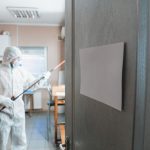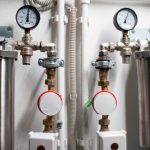Our Address:
Commercial water damage can disrupt business operations, damage property, and lead to costly repairs. In cities like St. Petersburg, Clearwater, Tampa, Largo, and Pinellas Park, frequent storms, flooding, and plumbing issues can result in unexpected water damage. Acting quickly and efficiently can help minimize damage and protect your property. Here’s how to handle commercial water damage in the best way possible.
1. Prioritize Safety First
The first step in addressing commercial water damage is to ensure the safety of employees and visitors. Water damage can present hazards such as electrical risks, slipping, and contamination, depending on the water source. In cities like Clearwater or Tampa, where heavy rains can cause stormwater flooding, water might be contaminated with debris or chemicals.
To ensure safety:
- Turn off electricity in the affected area if water is near electrical outlets or wiring.
- Evacuate the area if flooding or water damage presents an immediate hazard.
- Wear protective gear, such as rubber boots and gloves, before entering the affected area.
In commercial buildings in Pinellas Park and Largo, where the risk of storm-related flooding is higher, having a water damage response plan in place is critical to ensuring everyone’s safety.
2. Stop the Source of Water Damage
The next step in handling commercial water damage is to locate and stop the source of water. Water leaks or flooding can originate from a variety of sources, including:
- Broken pipes
- Faulty plumbing fixtures
- Roof leaks
- Stormwater runoff
In storm-prone areas like St. Petersburg and Tampa, roof damage or clogged gutters can lead to water infiltration during heavy rains. If the water damage is due to internal plumbing issues, such as a burst pipe, shut off the water supply immediately to prevent further damage. For roof leaks, try to contain the water with buckets or tarps until professional help arrives.
3. Contact a Professional Restoration Company
To handle commercial water damage efficiently, it’s essential to contact a professional restoration company that specializes in water damage cleanup. Water can quickly seep into walls, flooring, and ceilings, causing mold growth and structural damage. Companies like CIS Solutions, serving Clearwater, Largo, and surrounding areas, provide 24/7 emergency services to minimize water damage and restore your property.
A professional restoration company will:
- Assess the extent of the damage.
- Extract standing water using industrial-grade pumps and vacuums.
- Dry out affected areas using dehumidifiers and fans.
- Perform mold inspections to prevent future mold growth.
Engaging professionals ensures that the damage is addressed thoroughly and quickly, reducing the risk of further issues down the line.
4. Document the Damage for Insurance
While waiting for a restoration team, it’s important to document the damage for insurance purposes. Take photos and videos of the affected areas, including any damaged furniture, equipment, or inventory. This documentation is crucial when filing an insurance claim for water damage in your commercial property.
Businesses in Pinellas Park or Tampa, where weather-related water damage can be common, should keep a detailed record of the extent of the damage and any emergency repairs made before professional help arrives. The more evidence you provide to your insurance company, the easier it will be to secure compensation for repairs and lost business.
5. Remove Standing Water and Dry the Area
If it’s safe to do so, begin removing standing water and drying out the area while waiting for professionals to arrive. Use mops, towels, or wet vacuums to remove excess water. Opening windows and using fans can help speed up the drying process in Clearwater or St. Petersburg, where high humidity can slow down drying.
For larger spaces like warehouses or offices in Largo or Tampa, professional-grade equipment such as industrial fans and dehumidifiers is essential to thoroughly dry the area and prevent mold from forming.
6. Salvage and Protect Business Equipment and Inventory
After removing standing water, focus on salvaging important business equipment, inventory, and documents. Move items to a dry, secure area to prevent further damage. In commercial properties, electronics, furniture, and inventory can be significantly affected by water exposure.
For businesses in St. Petersburg or Pinellas Park, where storm damage might affect large areas of a building, it’s important to prioritize the protection of valuable items to minimize financial losses. Make sure to document any damaged equipment for insurance claims.
7. Check for Mold Growth
One of the biggest concerns after commercial water damage is the risk of mold growth. Mold can begin developing within 24-48 hours in damp conditions, especially in humid environments like Clearwater or Tampa. Mold not only damages property but can also pose serious health risks to employees and customers.
Professional restoration companies can conduct a thorough mold inspection and remediation if necessary. It’s crucial to address any mold growth early to prevent it from spreading throughout the building.
8. Repair and Restore
Once the immediate water damage is addressed, the next step is repairing and restoring your commercial property. This could involve replacing damaged drywall, flooring, or ceiling tiles, as well as restoring any electrical systems affected by water damage.
In cities like Largo and Clearwater, where water damage from storms can be significant, restoration efforts might also involve upgrading drainage systems or installing flood barriers to prevent future water damage. For businesses in Tampa, repairing and reinforcing the roof or windows can help protect against future storms.
9. Prevent Future Water Damage
After your property is restored, take steps to prevent future water damage. Regular maintenance and proactive measures can reduce the likelihood of future incidents. Some best practices for preventing future water damage include:
- Regularly inspecting plumbing, roofs, and gutters for signs of wear or damage.
- Installing water detection systems that alert you to leaks early.
- Ensuring proper drainage systems are in place to handle heavy rains, particularly in storm-prone areas like St. Petersburg and Pinellas Park.
- Maintaining your HVAC system to prevent water buildup from condensation.
Water damage can be a costly and disruptive issue for any commercial property. Whether your business is located in St. Petersburg, Clearwater, Tampa, Largo, or Pinellas Park, responding quickly and efficiently is key to minimizing the damage and getting back to normal operations. By prioritizing safety, stopping the source of water, contacting professional restoration services, and taking preventive measures, you can handle commercial water damage with confidence.





